Index


Review: Fastest GTX 460 to date
A few days ago, Nvidia launched its GF104-based GTX 460 card. This means that second generation Fermi is here but we’re talking about a mid-range, performance oriented product rather than a high-end chip. Gamers and the general public who’ve been waiting for a more affordable Nvidia DX11 offering will probably find the new GTX 460 to be a nice deal. Thermals, consumption and noise were the GF100’s three main flaws, but Nvidia made sure that this is not the case with the GTX 460.
GTX 460 768MB's recommended pricing is $200/€200 whereas 1GB versions are about €30 more. So, there are currently two versions of GF104-based Geforce GTX 460, with the differences being memory, bandwidth and TDP, which on the 1GB version stands at 160W (idle TDP is 22W). The clocks are identical – 675MHz GPU, shaders (CUDA cores) at 1350Mhz and the memory at 3600MHz (effectively).
We'll refer to the GTX 460 with 1024MB of GDDR5 as the „faster“ one, as it comes with 256-bit memory bus, whereas the „slower“ card comes with 768MB of GDDR5 memory on a 192-bit bus. The GTX 460 768MB's memory subsystem is made of three 64-bit memory controllers (192-bit), whereas the GTX 460 1024MB has four 64-bit memory controllers (256-bit). Although operating clocks are the same, the 1GB version still has a performance advantage as erasing 256MB of memory took a piece of the ROP engine as well. GTX 460 1GB card comes with 32 ROPs whereas the 768MB version has 24 ROPs.
GF104 is not mere GF100 with a few disabled components, but rather a new chip built in 40nm but still based on Fermi architecture. GF104 packs 1.95 billion transistors whereas the GF100 has 3 billion. Compared to the GF100, the new GPU is smaller and much cooler.
GTX 460's graphics processor has 336 CUDA cores and 56 texture units at its disposal. By regrouping resources within the chip that's aimed at mid-range markets, Nvidia got some nice performance and the GTX 460 manages to beat the GTX 465 in many tests, despite the fact that it has less shader cores.
Almost all Nvidia partners were ready with their GTX 460 cards on launch day, many of which come pre-overclocked. As far as we know, Gainward took the biggest step in overclocking and managed to push the GPU from the reference 675MHz to 800MHz. Nvidia has said that the majority of GTX 460 cards will run at 800MHz with no trouble, and it seems like Gainward found the exact source of this “majority” and now sells them branded as GTX 460 1024MB Golden Sample Goes Like Hell.
Gainward’s GTX 460 1GB Golden Sample Goes Like Hell belongs to Gainward’s GOOD line (Gainward Optimized Own Design). The card comes with highest operating clocks among the GTX 460 pack, custom-designed cooling with GP (Gainward Pipes) and a multitude of outs, which means there’s no need for additional adapters.
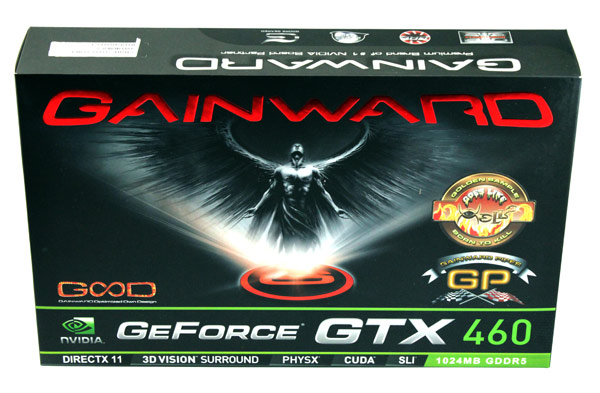
The box is a new design, which Gainward uses since Fermi came around. Since the GTX 460 is the smallest Fermi card around, the box is pretty small as well.
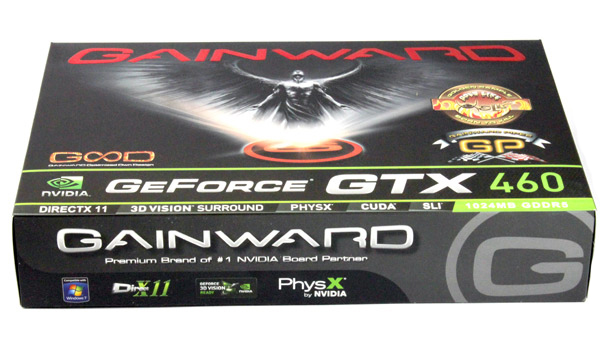
Gainward has become Nvidia’s Premium partner, meaning they’re exclusive to the green team and the box confirms this. Note, however, that if you own Gainward’s AMD card, you’re still eligible for technical support until your warranty expires.
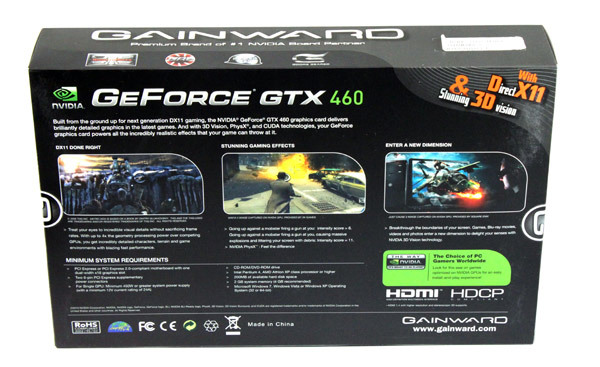
GTX 460 GS-GLH is safely sitting within the cardboard box.
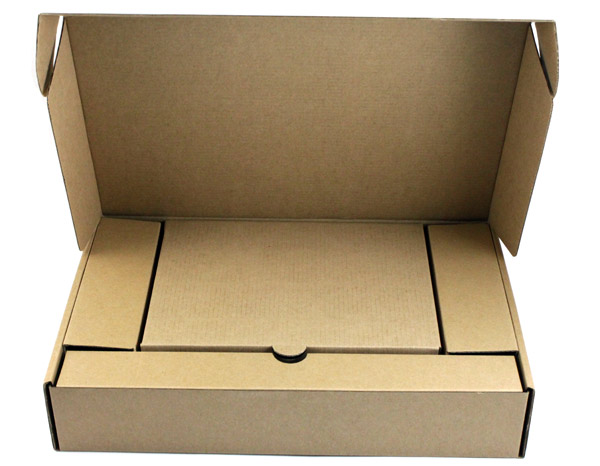
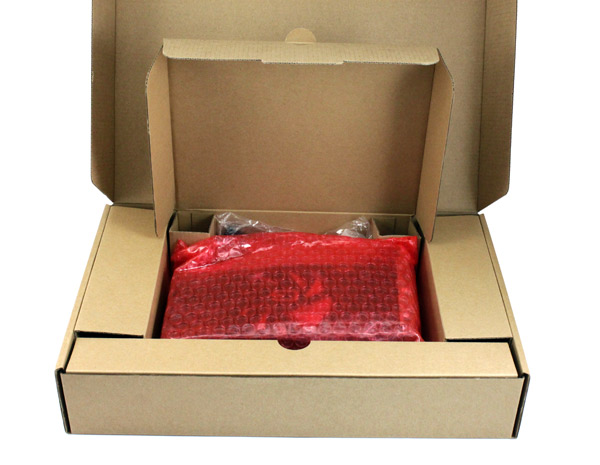
Gainward included its useful Expertool on the CD and this tool will help you in monitoring and overclocking your card.
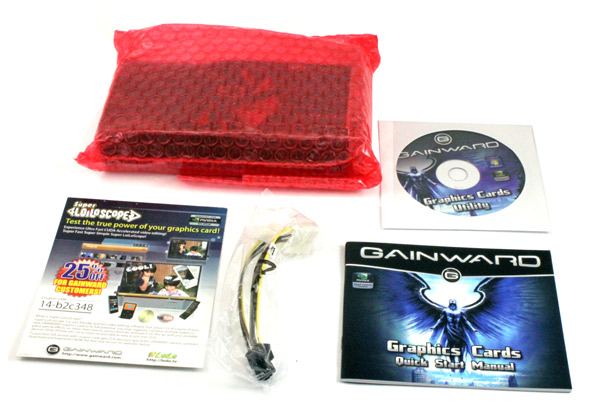
Although there was no need for non-reference cooling this time around, since the reference cooling is quiet and efficient, Gainward still strapped the card with its cooler. Furthermore, the company redesigned the PCB, which is now shorter than reference. Gainward GTX 460 1024MB GDDR5 Golden Sample Goes Like Hell runs at 800MHz for the GPU and 1600 for the shaders, whereas the memory is at 1000MHz (4000MHz effectively). Just for comparison purposes, reference clocks are 675MHz GPU and 900MHz memory (3600MHz effectively). Thankfully, with such high operating clocks, many won’t even need to overclock the card further.
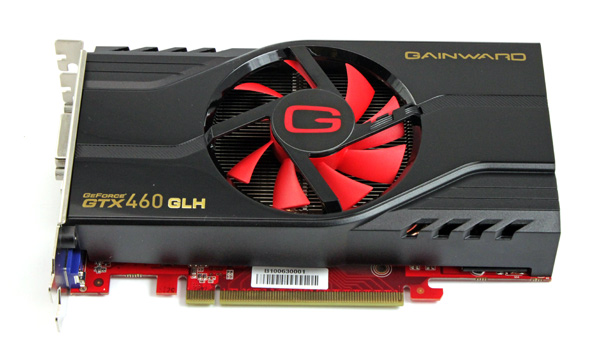
So, we’re talking about a 1024MB memory on a 256-bit memory interface and with 32 ROPs. We must say that GS-Goes Like Hell fully deserves its name, as you’ll soon see for yourself. The cooler does its job well and the card is quiet in both operation modes – idle and 3D.
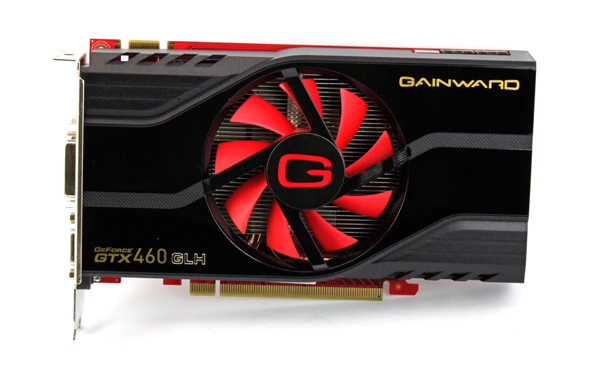
Gainward continued the tradition of offering many different video outs – two dual-link DVIs, VGA and HDMI (standard one, not the mini-HDMI you’ll find on reference cards). GF104 also got an updated video processor capable of bitstreaming Dolby TrueHD and DTS-HD Master Audio sountracks from Blu-ray movies.
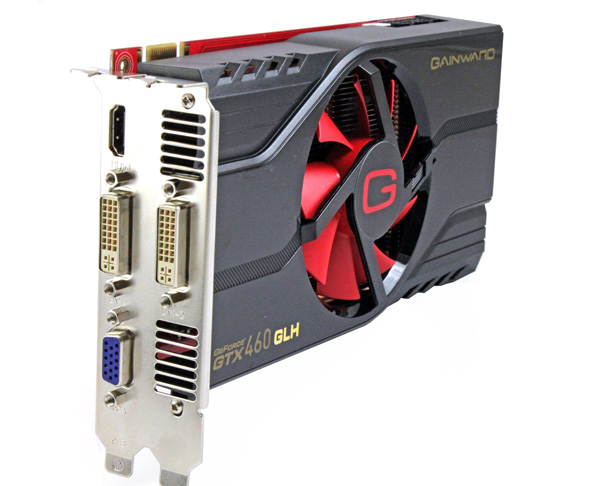
GF100-based cards had plenty of issues with thermals, but GF104-based GTX 460 runs much cooler in comparison. Nvidia could’ve perhaps included a standard HDMI connector on the reference card’s video out panel, but they chose not to, probably in order to leave some space for the air outlet. The picture below shows how Gainward implemented their video outs (the card on the bottom is the reference GTX 465).
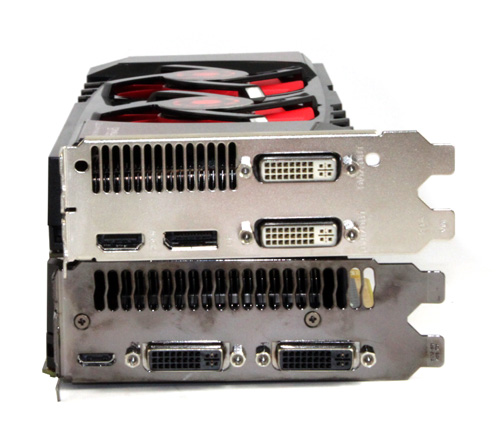
The following picture compares the GTX 460 GS-GLH to the reference-designed EVGA GTX 460.
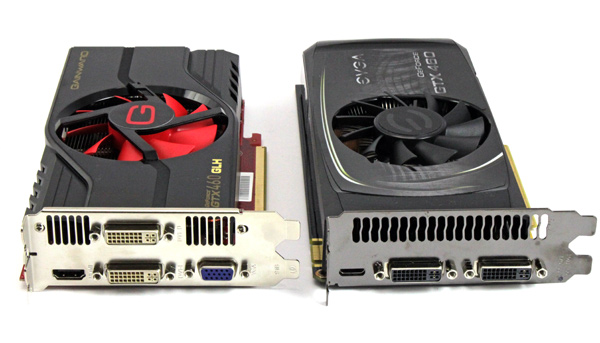
Nvidia’s reference cooler uses a fan placed in the center, which means that some heat will end up in the case as well. This means that there’s not much airflow around the I/O panel, and the same goes for Gainward’s GTX 460 GS-GLH.
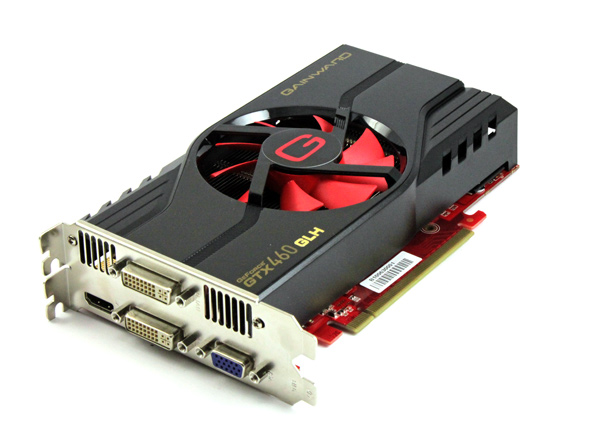
The reference GTX 460 is 210mm long whereas Gainward’s GS-GLH is 188mm. The reference card is powered via two 6-pin power connectors. The reference GTX 460 1GB card’s TDP stands at 160W, but you should expect Gainward to top this number as the 1GB GS-GLH comes with a significant factory overclock. Power connectors are placed on the upper side of the card, rather than at the end which is the case with reference GTX 460 cards.

Geforce GTX 460 is a mid-range product so there’s no 3-way SLI support. The card will support 2-way SLI which means that the card comes with only one SLI connector.
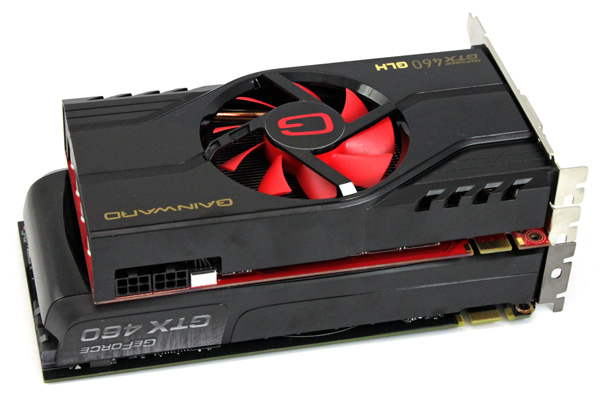

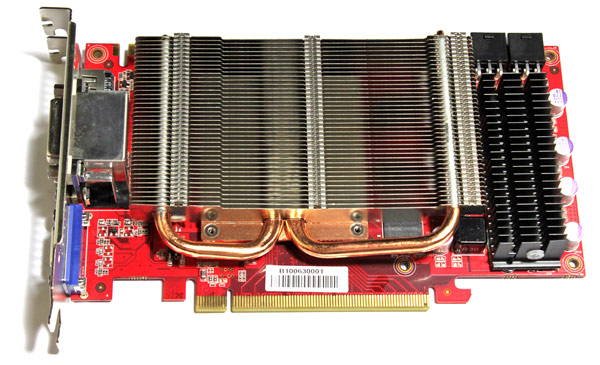
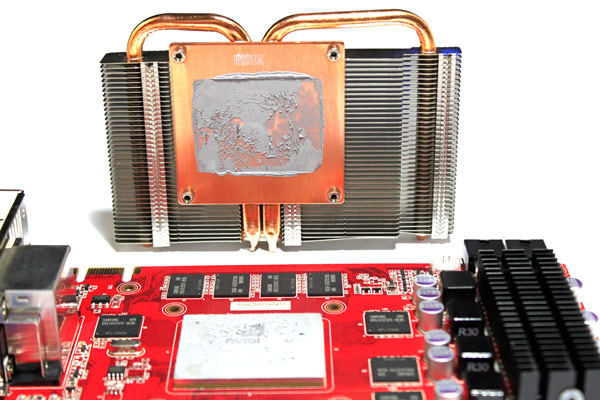
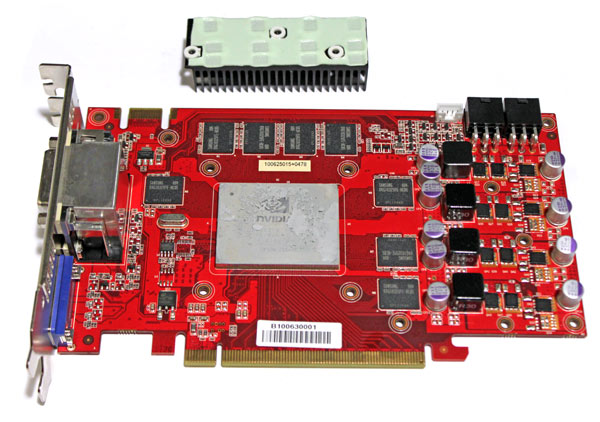

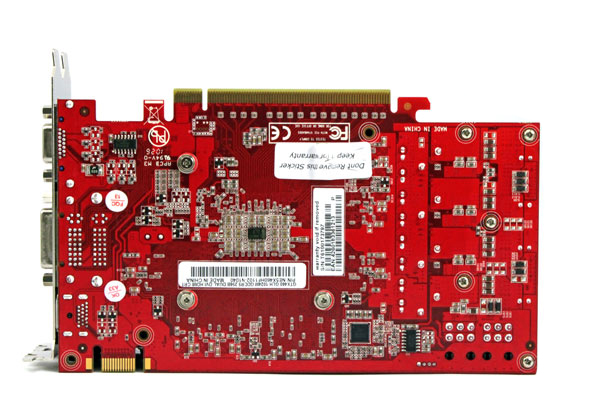
Testbed:
Motherboard: EVGA 4xSLI
CPU: Core i7 965 XE (Intel EIST and Vdrop enabled)
Memory: 6GB Corsair Dominator 12800 7-7-7-24
Harddisk: OCZ Vertex 2 100 GB
Power Supply: CoolerMaster Silent Pro Gold 800W
Case: CoolerMaster HAF X
Fan Controler: Kaze Master Pro 5.25"
Operating System: Win7 64-bit
258.80_desktop_win7_winvista_64bit_english
10.6 CCC
Gainward GTX 460 1GB GS-GLH card comes overclocked from reference 675MHz to 800MHz for the GPU and from 900MHz to 1000MHz for the memory. Such high clocks allow this card to score about 25% better than the GTX 465. Compared to the HD 5850, Gainward’s GTX 460 1GB GS-GLH is about 14% faster in Performance and by about 8% in Extreme mode.
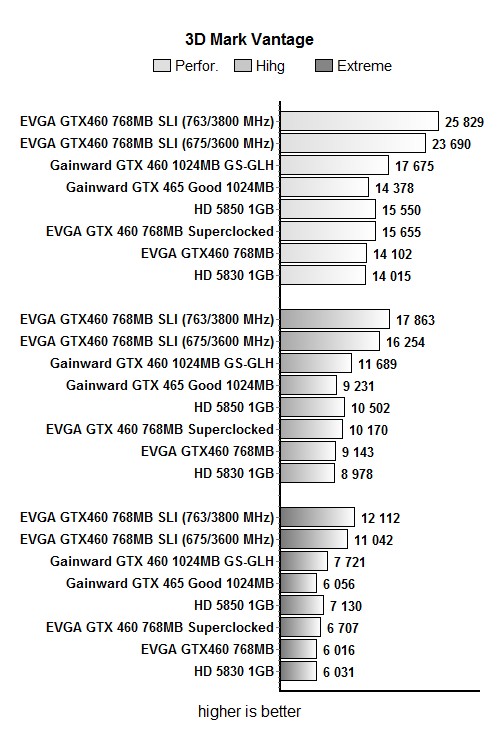
In Aliens vs. Predator, Gainward's GTX 460 1GB shows that it can run on par with the HD 5850, at least when we're talking about at 1920x1200 and AA. In the aforementioned scenario, Gainward's GTX 460 GS-GLH outruns the HD 5850 by 4%. The same card outruns its little brother, the GTX 460 768MB card, by more than 22%.
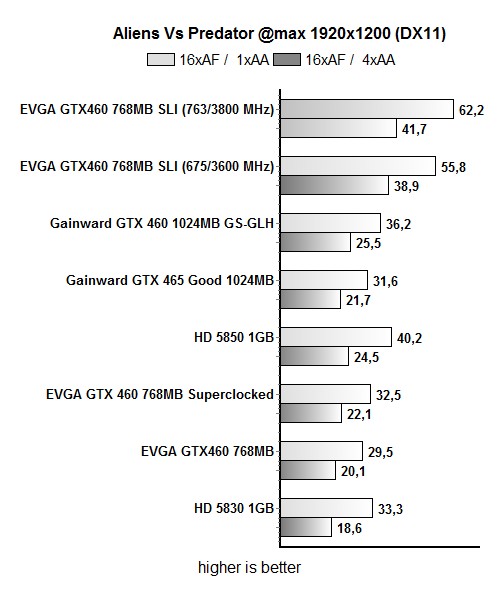
Dirt 2 reports the biggest performance difference between the GTX 460 1GB GS-GLH and HD 5850 so far.
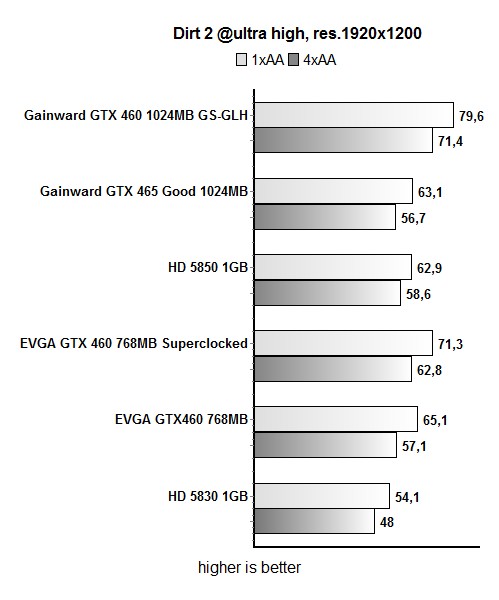
At 1920x1200 in Metro 2033 (high video settings, DX11 FX), Gainward's GTX 460 GS-GLH almost scores a playable framerate; it's slightly faster than the HD 5850.

Nvidia's two new cards, the GTX 460 768MB and GTX 460 1GB, are excellent overclockers and FurMark results paint a nice picture on the quality of Nvidia's new cards. The 768MB Superclocked version beats the HD 5830 by 6% and the 1GB GS-GLH version beats the HD 5850 by 7%.
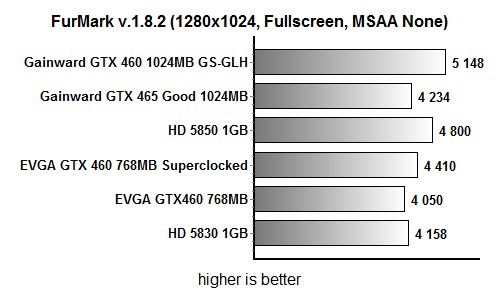

Gainward’s GTX 460 1GB GS-GLH card has a small but powerful cooler, which allows for manual RPM regulation via the provided Expertool.
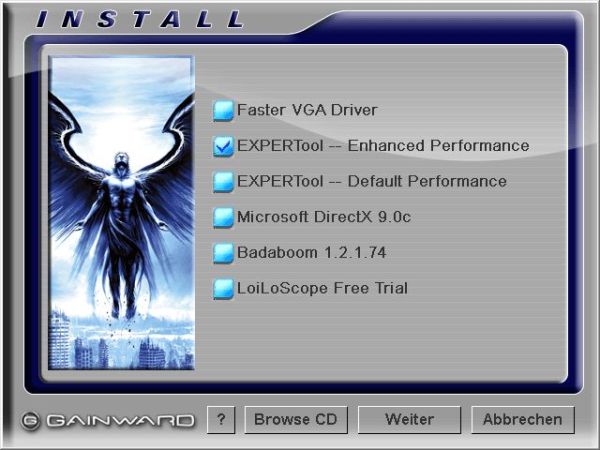
You can use Expertool to alter clocks as well.
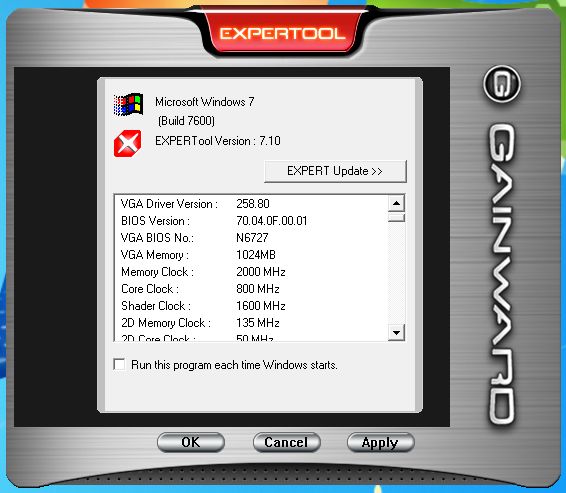
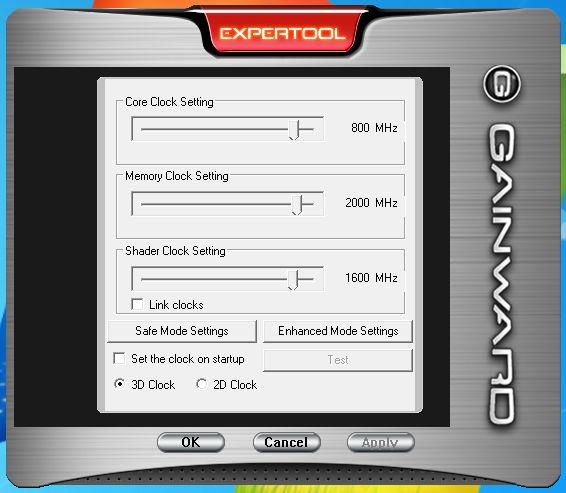
The tool does not provide exact fan RPM readouts, but does display RPM count in percentages. We pushed the fan at 100% RPM and measured 65°C on the GPU while running FurMark, but the fan ran too loud for our liking.
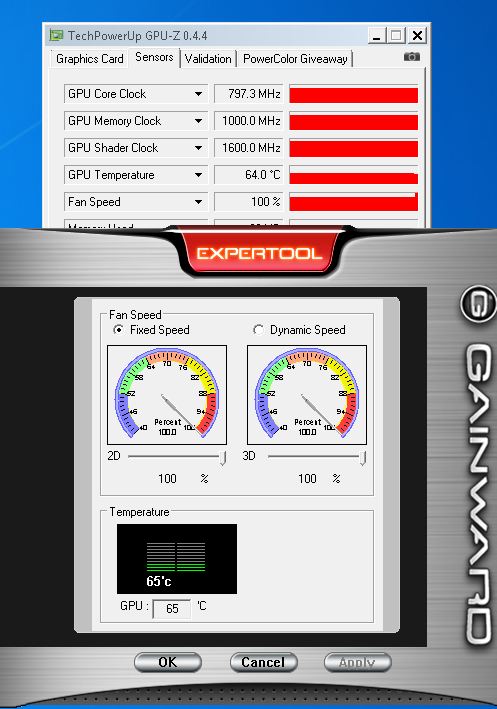
The dynamic fan mode, which is on by default, lowered the fan speed to 59% in the same test and temperatures climbed to 76°C but the card ran pretty silent. Nvidia and most of its partners did a great job this time around and we can’t complain about noise levels.
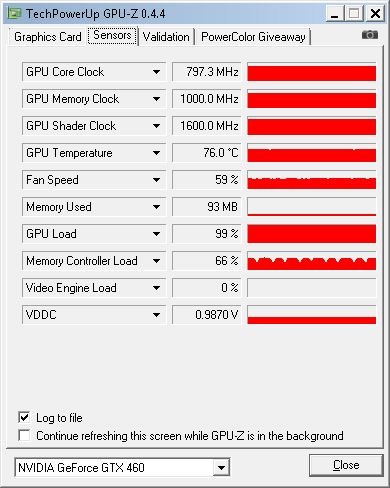
We pushed the card to 840MHz for the GPU and 1080 (4320MHz effectively) for the memory. This resulted in GPU temperatures going up by mere 1°C and although the fan RPM also went up from 59% to 62% - we still couldn’t call the card loud.
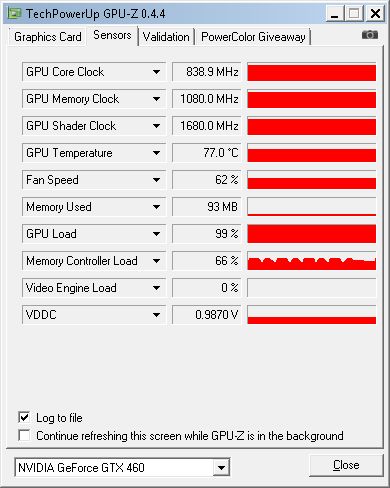
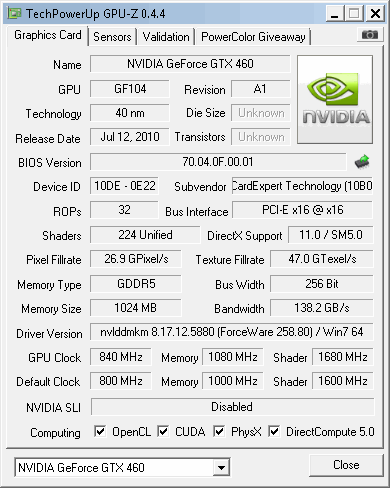
Overclocking the GPU to 850MHz is a feat we managed only after increasing the fan RPM to 100%. GPU temperature was at 67°C, but we decided not to go on with the test as the fan was simply to loud.
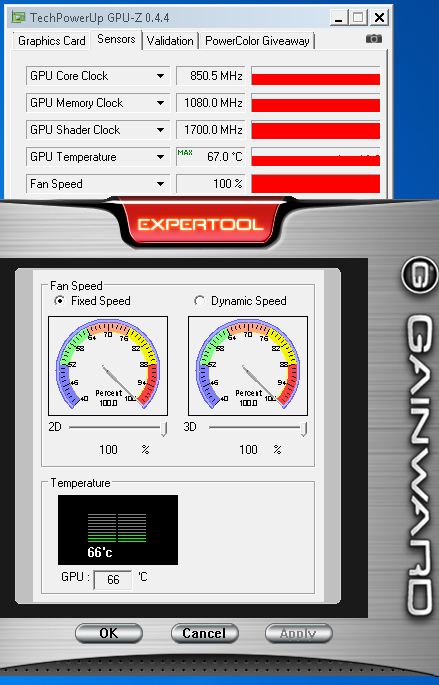
Note that you’ll have to check “link clocks” in Expertool when overclocking GTX 460 and the rest of Fermi-based cards, because shaders run at twice the speed of the GPU.
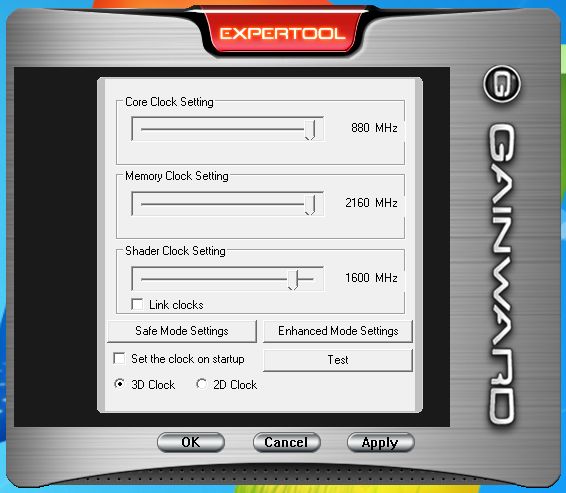
GTX 460 GS-GLH is inaudible in idle mode and the temperatures are at about 31°C with 40% fan RPM. The card ran quiet throughout our testing, including our overclocking tests where the card ran at 840MHz.
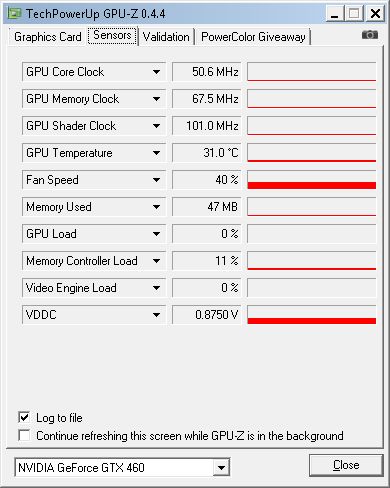
Our test rig strapped with the GTX 460 GS-GLH 1024MB card consumed about 153W, whereas using EVGA’s GTX 460 768MB Superclocked resulted in 139W consumption. FurMark test caused these numbers to jump to 299W and 349W, respectively. After overclocking EVGA’s GTX 460 768MB card to 870MHz, our rig consumed 324W, which means that the GTX 460 1GB needs more power. After overclocking Gainward’s GTX 460 GS-GLH card to 840MHz, our rig consumed 360W.
Gainward’s GTX 460 1GB Golden Sample Goes Like Hell is the fastest GTX 460 we’ve seen so far, with the GPU running at 800MHz and the memory at 4000MHz (effectively). Just to remind you, reference clocks are at 675MHz for the GPU and 3600 for the memory.
By announcing the GTX 460, Nvidia announced a strong intent to conquer the mid-range graphics segment, where AMD's presence is pretty strong. Price-wise, the GTX 460's main competitor will be the HD 5830 but Nvidia made sure to announce at least two GTX 460 models in order to offer more choices to its customers. The weaker model comes with 768MB of memory, 192-bit memory interface and is priced at about €180, which is the same money the HD 5830 goes for. AMD didn't officially announce pricecuts, but you never know. In fact, if Nvidia's new offer fares well you can probably expect some pricecuts on Radeon HD 5850/5830 cards.
The stronger GTX 460 model comes with 1GB of memory and uses 256-bit memory interface, and our today's card is Gainward's take on this card dubbed the GTX 460 Golden Sample Goes Like Hell. Gainward did a great job in overclocking the card so that it easily competes with the HD 5850 and beats it in few tests. As far as cooling goes, GTX 460 GS-GLH’s custom cooling does a great job and runs quietly both in idle and 3D. The card has HDMI, VGA and DVI outs and we can’t forget the newer video engine as well.
If you’re looking for a fast DirectX11 card for gaming, our today’s Gainward GTX 460 1GB GS-GLH will be a great choice, but such a high overclock comes at a price – it’s priced about €30 higher than the reference model. So, let’s recap - premium overclocking that significantly adds to the performance, warranty, quiet operation and nice consumption make Gainward’s GTX 460 Golden Sample Goes Like Hell a great choice.




